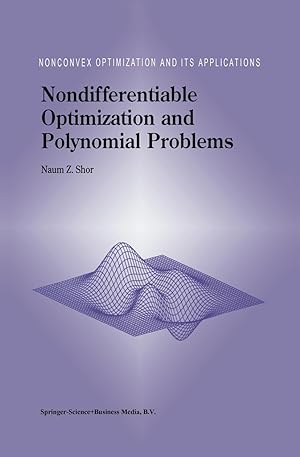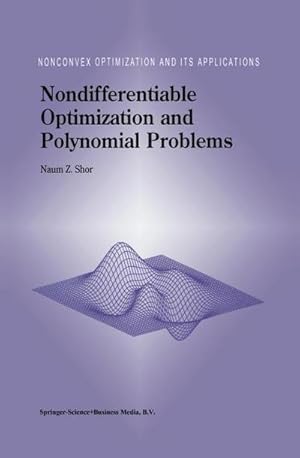Nondifferentiable Optimization Polynomial Problems by Shor N Z (19 results)
Search filters
Product Type
- All Product Types
- Books (19)
- Magazines & Periodicals (No further results match this refinement)
- Comics (No further results match this refinement)
- Sheet Music (No further results match this refinement)
- Art, Prints & Posters (No further results match this refinement)
- Photographs (No further results match this refinement)
- Maps (No further results match this refinement)
- Manuscripts & Paper Collectibles (No further results match this refinement)
Condition Learn more
- New (17)
- As New, Fine or Near Fine (2)
- Very Good or Good (No further results match this refinement)
- Fair or Poor (No further results match this refinement)
- As Described (No further results match this refinement)
Binding
Collectible Attributes
- First Edition (No further results match this refinement)
- Signed (No further results match this refinement)
- Dust Jacket (No further results match this refinement)
- Seller-Supplied Images (7)
- Not Print on Demand (14)
Language (1)
Price
- Any Price
- Under £ 20 (No further results match this refinement)
- £ 20 to £ 40 (No further results match this refinement)
- Over £ 40
Free Shipping
- Free Shipping to U.S.A. (No further results match this refinement)
Seller Location
Seller Rating
-
Nondifferentiable Optimization and Polynomial Problems (Nonconvex Optimization and Its Applications)
Seller: Best Price, Torrance, CA, U.S.A.
Condition: New. SUPER FAST SHIPPING.
-
Nondifferentiable Optimization and Polynomial Problems (Nonconvex Optimization and Its Applications, 24)
Seller: Best Price, Torrance, CA, U.S.A.
Condition: New. SUPER FAST SHIPPING.
-
Condition: New.
-
Condition: New.
-
Nondifferentiable Optimization and Polynomial Problems (Nonconvex Optimization and Its Applications)
Seller: Ria Christie Collections, Uxbridge, United Kingdom
Condition: New. In English.
-
Nondifferentiable Optimization and Polynomial Problems (Nonconvex Optimization and Its Applications, 24)
Seller: Ria Christie Collections, Uxbridge, United Kingdom
Condition: New. In.
-
Condition: New. pp. 416.
-
Taschenbuch. Condition: Neu. Nondifferentiable Optimization and Polynomial Problems | N. Z. Shor | Taschenbuch | xvii | Englisch | 2011 | Springer US | EAN 9781441947925 | Verantwortliche Person für die EU: Springer Verlag GmbH, Tiergartenstr. 17, 69121 Heidelberg, juergen[dot]hartmann[at]springer[dot]com | Anbieter: preigu.
-
Gebunden. Condition: New. Polynomial extremal problems (PEP) constitute one of the most important subclasses of nonlinear programming models. Their distinctive feature is that an objective function and constraints can be expressed by polynomial functions in one or several variables.
-
Condition: Sehr gut. Zustand: Sehr gut | Sprache: Englisch | Produktart: Bücher.
-
Nondifferentiable Optimization and Polynomial Problems
Published by Springer US, Springer US, 2011
ISBN 10: 1441947922 ISBN 13: 9781441947925
Language: English
Seller: AHA-BUCH GmbH, Einbeck, Germany
Taschenbuch. Condition: Neu. Druck auf Anfrage Neuware - Printed after ordering - Polynomial extremal problems (PEP) constitute one of the most important subclasses of nonlinear programming models. Their distinctive feature is that an objective function and constraints can be expressed by polynomial functions in one or several variables. Let :e = {:e 1, . , :en} be the vector in n-dimensional real linear space Rn; n PO(:e), PI (:e), . , Pm (:e) are polynomial functions in R with real coefficients. In general, a PEP can be formulated in the following form: (0.1) find r = inf Po(:e) subject to constraints (0.2) Pi (:e) =0, i=l, . ,m (a constraint in the form of inequality can be written in the form of equality by introducing a new variable: for example, P( x) ~ 0 is equivalent to P(:e) + y2 = 0). Boolean and mixed polynomial problems can be written in usual form by adding for each boolean variable z the equality: Z2 - Z = O. Let a = {al, . ,a } be integer vector with nonnegative entries {a;}f=l. n Denote by R[a](:e) monomial in n variables of the form: n R[a](:e) = IT :ef'; ;=1 d(a) = 2:7=1 ai is the total degree of monomial R[a]. Each polynomial in n variables can be written as sum of monomials with nonzero coefficients: P(:e) = L caR[a](:e), aEA{P) IX x Nondifferentiable optimization and polynomial problems where A(P) is the set of monomials contained in polynomial P.
-
Nondifferentiable Optimization and Polynomial Problems (Nonconvex Optimization and Its Applications)
Seller: Revaluation Books, Exeter, United Kingdom
Paperback. Condition: Brand New. 412 pages. 9.45x6.30x0.94 inches. In Stock.
-
Nondifferentiable Optimization and Polynomial Problems (Nonconvex Optimization and Its Applications, 24)
Seller: Mispah books, Redhill, SURRE, United Kingdom
Paperback. Condition: Like New. Like New. book.
-
Nondifferentiable Optimization and Polynomial Problems
Published by Springer Us Mär 1998, 1998
ISBN 10: 0792349970 ISBN 13: 9780792349976
Language: English
Seller: AHA-BUCH GmbH, Einbeck, Germany
Buch. Condition: Neu. Neuware - Polynomial extremal problems (PEP) constitute one of the most important subclasses of nonlinear programming models. Their distinctive feature is that an objective function and constraints can be expressed by polynomial functions in one or several variables. Let :e = {:e 1, . , :en} be the vector in n-dimensional real linear space Rn; n PO(:e), PI (:e), . , Pm (:e) are polynomial functions in R with real coefficients. In general, a PEP can be formulated in the following form: (0.1) find r = inf Po(:e) subject to constraints (0.2) Pi (:e) =0, i=l, . ,m (a constraint in the form of inequality can be written in the form of equality by introducing a new variable: for example, P( x) ~ 0 is equivalent to P(:e) + y2 = 0). Boolean and mixed polynomial problems can be written in usual form by adding for each boolean variable z the equality: Z2 - Z = O. Let a = {al, . ,a } be integer vector with nonnegative entries {a;}f=l. n Denote by R[a](:e) monomial in n variables of the form: n R[a](:e) = IT :ef'; ;=1 d(a) = 2:7=1 ai is the total degree of monomial R[a]. Each polynomial in n variables can be written as sum of monomials with nonzero coefficients: P(:e) = L caR[a](:e), aEA{P) IX x Nondifferentiable optimization and polynomial problems where A(P) is the set of monomials contained in polynomial P.
-
Nondifferentiable Optimization and Polynomial Problems
Published by Springer US Okt 2011, 2011
ISBN 10: 1441947922 ISBN 13: 9781441947925
Language: English
Seller: BuchWeltWeit Ludwig Meier e.K., Bergisch Gladbach, Germany
Taschenbuch. Condition: Neu. This item is printed on demand - it takes 3-4 days longer - Neuware -Polynomial extremal problems (PEP) constitute one of the most important subclasses of nonlinear programming models. Their distinctive feature is that an objective function and constraints can be expressed by polynomial functions in one or several variables. Let :e = {:e 1, . , :en} be the vector in n-dimensional real linear space Rn; n PO(:e), PI (:e), . , Pm (:e) are polynomial functions in R with real coefficients. In general, a PEP can be formulated in the following form: (0.1) find r = inf Po(:e) subject to constraints (0.2) Pi (:e) =0, i=l, . ,m (a constraint in the form of inequality can be written in the form of equality by introducing a new variable: for example, P( x) ~ 0 is equivalent to P(:e) + y2 = 0). Boolean and mixed polynomial problems can be written in usual form by adding for each boolean variable z the equality: Z2 - Z = O. Let a = {al, . ,a } be integer vector with nonnegative entries {a;}f=l. n Denote by R[a](:e) monomial in n variables of the form: n R[a](:e) = IT :ef'; ;=1 d(a) = 2:7=1 ai is the total degree of monomial R[a]. Each polynomial in n variables can be written as sum of monomials with nonzero coefficients: P(:e) = L caR[a](:e), aEA{P) IX x Nondifferentiable optimization and polynomial problems where A(P) is the set of monomials contained in polynomial P. 416 pp. Englisch.
-
Nondifferentiable Optimization and Polynomial Problems
Seller: moluna, Greven, Germany
Condition: New. Dieser Artikel ist ein Print on Demand Artikel und wird nach Ihrer Bestellung fuer Sie gedruckt. Polynomial extremal problems (PEP) constitute one of the most important subclasses of nonlinear programming models. Their distinctive feature is that an objective function and constraints can be expressed by polynomial functions in one or several variables.
-
Nondifferentiable Optimization and Polynomial Problems
Published by Springer US, Springer US Okt 2011, 2011
ISBN 10: 1441947922 ISBN 13: 9781441947925
Language: English
Seller: buchversandmimpf2000, Emtmannsberg, BAYE, Germany
Taschenbuch. Condition: Neu. This item is printed on demand - Print on Demand Titel. Neuware -Polynomial extremal problems (PEP) constitute one of the most important subclasses of nonlinear programming models. Their distinctive feature is that an objective function and constraints can be expressed by polynomial functions in one or several variables. Let :e = {:e 1, . , :en} be the vector in n-dimensional real linear space Rn; n PO(:e), PI (:e), . , Pm (:e) are polynomial functions in R with real coefficients. In general, a PEP can be formulated in the following form: (0.1) find r = inf Po(:e) subject to constraints (0.2) Pi (:e) =0, i=l, . ,m (a constraint in the form of inequality can be written in the form of equality by introducing a new variable: for example, P( x) ~ 0 is equivalent to P(:e) + y2 = 0). Boolean and mixed polynomial problems can be written in usual form by adding for each boolean variable z the equality: Z2 - Z = O. Let a = {al, . ,a } be integer vector with nonnegative entries {a;}f=l. n Denote by R[a](:e) monomial in n variables of the form: n R[a](:e) = IT :ef'; ;=1 d(a) = 2:7=1 ai is the total degree of monomial R[a]. Each polynomial in n variables can be written as sum of monomials with nonzero coefficients: P(:e) = L caR[a](:e), aEA{P) IX x Nondifferentiable optimization and polynomial problems where A(P) is the set of monomials contained in polynomial P.Springer Verlag GmbH, Tiergartenstr. 17, 69121 Heidelberg 416 pp. Englisch.
-
Nondifferentiable Optimization and Polynomial Problems
Seller: Majestic Books, Hounslow, United Kingdom
Condition: New. Print on Demand pp. 416 49:B&W 6.14 x 9.21 in or 234 x 156 mm (Royal 8vo) Perfect Bound on White w/Gloss Lam.
-
Nondifferentiable Optimization and Polynomial Problems
Seller: Biblios, Frankfurt am main, HESSE, Germany
Condition: New. PRINT ON DEMAND pp. 416.










